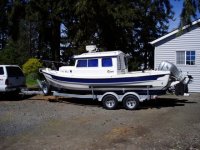Sawdust
New member
- Joined
- Nov 1, 2003
- Messages
- 1,400
- Reaction score
- 0
- C Dory Year
- 1984
- C Dory Model
- 22 Classic
Hey Casey,
Don't change hobbies, and get your lazy butt back up here and visit for a while. Miss you!
As I've said before (over and over to the point of yuk) I do this kind of thing a lot. Did it for Johnson on some of their big engines, and my predicted log racing days required precise (wow, how precise can you get) planning numbers.
The really practical numbers, like those El and Bill get from thousands of miles and countless fill-up checks, are very difficult to get, and are most important on long legs. So many variables are significant to our little guys. Total weight, hull condition, wind (both direction and velocity), topside drag, lateral and longitudinal trim, engine thrust angle, and the list goes on. Most of the published tests I've seen on boats I'm familiar with are very favorable to the boat/engine combination. They are usually done under ideal conditions, with a professional driver, and accurately measured with a radar gun. New boat, clean bottom, etc.These are not real world figures.
The GPS/ chart plotter systems have for the most part eliminated plotting errors. When I was teaching this stuff to professional seaman, I'd often find plotting errors of 2 or 3 tenths of mile on a leg. Steering errors add to that, so the actual miles run were generally more than the plot.
With the 5 22s I've had -- different main engines -- I have never been able to get 5.0 smpg. I'll get some numbers on the new 2-stroke, but with my Yamaha and Hondas I could get about 4 NMPG if, IF, conditions were ideal. Wind on either beam that requires rudder compensation, or bow-down trim to compensate for headwind chop, all decrease the NMPG significantly. I'm an old safety dude (coward a better word), so my planning figure is 3NMPG. I normal cruise long legs. Here to Bamfield is about 200 NM, and I like to have a decent reserve. With the limited range of the 22, that means I've got to stop enroute (Port Angeles, Sooke, or Neah Bay) and top off. Beats running out of fuel, and I agree with Casey -- better to slow to hull speed and go twice as far. Take along a good book - and have a good autopilot!
This doesn't help, but puts another oar in the water,
Dusty
Don't change hobbies, and get your lazy butt back up here and visit for a while. Miss you!
As I've said before (over and over to the point of yuk) I do this kind of thing a lot. Did it for Johnson on some of their big engines, and my predicted log racing days required precise (wow, how precise can you get) planning numbers.
The really practical numbers, like those El and Bill get from thousands of miles and countless fill-up checks, are very difficult to get, and are most important on long legs. So many variables are significant to our little guys. Total weight, hull condition, wind (both direction and velocity), topside drag, lateral and longitudinal trim, engine thrust angle, and the list goes on. Most of the published tests I've seen on boats I'm familiar with are very favorable to the boat/engine combination. They are usually done under ideal conditions, with a professional driver, and accurately measured with a radar gun. New boat, clean bottom, etc.These are not real world figures.
The GPS/ chart plotter systems have for the most part eliminated plotting errors. When I was teaching this stuff to professional seaman, I'd often find plotting errors of 2 or 3 tenths of mile on a leg. Steering errors add to that, so the actual miles run were generally more than the plot.
With the 5 22s I've had -- different main engines -- I have never been able to get 5.0 smpg. I'll get some numbers on the new 2-stroke, but with my Yamaha and Hondas I could get about 4 NMPG if, IF, conditions were ideal. Wind on either beam that requires rudder compensation, or bow-down trim to compensate for headwind chop, all decrease the NMPG significantly. I'm an old safety dude (coward a better word), so my planning figure is 3NMPG. I normal cruise long legs. Here to Bamfield is about 200 NM, and I like to have a decent reserve. With the limited range of the 22, that means I've got to stop enroute (Port Angeles, Sooke, or Neah Bay) and top off. Beats running out of fuel, and I agree with Casey -- better to slow to hull speed and go twice as far. Take along a good book - and have a good autopilot!
This doesn't help, but puts another oar in the water,
Dusty

